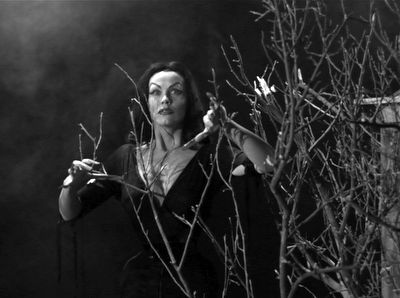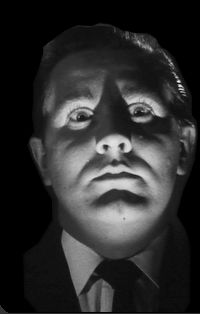"Learn to see the ‘worst’ films; they are sometimes sublime."
| -- Ado Kyrou, Surrealisme au Cinema
|
One of my fondest memories of a communal movie experience is seeing my first Ed Wood retrospective. This was around 1980 at one of Los Angeles’s early rep houses, the Vista in Silverlake. This mini-movie palace, with an interior designed as an Egyptian tomb with an imposing row of sarcophagi staring down at the audience, had an ideal ambiance for the resurrection of the cross-dressing auteur, and Hollywood came out in force. Attendees included Diane Keaton and Warren Beatty, but only the theater’s staff took any interest in the laughing, loaded pair, trying in vain to get their autograph. The audience was here for one thing: Ed Wood. Howls of laughter rang through the rafters, but there was genuine affection too, and a sense of history being made, or remade, as Wood’s return to the cultural firmament began.
This was the era of the dreaded Medveds’ book The Golden Turkey Awards (1980), which forever stamped Wood (1924-1978) in the mainstream mind as the "worst director ever" and his masterpiece Plan 9 from Outer Space as the "worst movie ever." Of course, we must be grateful to these sneering dolts for bringing attention to the film, any attention, even as we deride their smugness and, really, stupidity. ("Stupid earthlings, stupid, stupid!" as Eros the alien said in Plan 9.) Surely any lousy, boring mainstream movie is worse than the constantly surprising, intensely weird, totally personal, never dull Wood films. (Equally suspect in the Medved mold is the overrated Mystery Science Theater 3000, which should have aimed at bigger Hollywood targets. Why Teenage Monster and not Top Gun?) Fortunately, there was an ongoing effort to counter the Medved school. Aficionados who’d worshipped their sleazy idols in private started coming out of the closet, and the seedy glories of such low-budget auteurs as Herschel Gordon Lewis, Al Adamson, Doris Wishman, Joe Sarno, David Friedman, and a host of others were creeping back to their rightful place in the culture. Along with Kroger Babb and a handful of other pioneers, Ed Wood stands out as one of the pioneers of personal, indie, exploitation cinema.

Vampira peers at a potential victim in Plan 9 From Outer Space.
(© Englewood Entertainment. All rights reserved.))
Wood had no taste, thank goodness, and little "talent" as that term is generally understood. His films are filled with technical mistakes, incongruities, transparent special effects, lousy acting, and an air of naivete that triggers both audience sympathy and laughter. Through some mysterious process surely unknown even to Wood, these elements coalesce in his best films (Glen or Glenda and Plan 9 from Outer Space) to create classic outsider art. The films have all kinds of recurring themes -- the plight of the outsider is a biggie -- and motifs -- his placement of actors in the frame is unique -- for those who care to look. And in toying with -- nay, destroying -- the very concept of a linear narrative, they have a modern quality that belies their age. A Wood film is as instantly recognizable as one by Orson Welles, Sam Fuller, Nicholas Ray, or any of the more respected auteurs.
It’s a happy irony that the man who rarely had more than a pittance for his movies should now be presented on the plushest high-tech video format, DVD. But thanks to Image Entertainment, which licensed the films from rights holder Wade Williams, four of Wood’s "anti-classics" are now available to feed the enduring fetish for this director who, in his way, remains a model for the indie director with drive, sensibility, and no money.
NEXT PAGE »
Go to:
Introduction
Glen or Glenda?
Jail Bait
Bride of the Monster
Plan 9 From Outer Space
ED WOOD ON DVD









